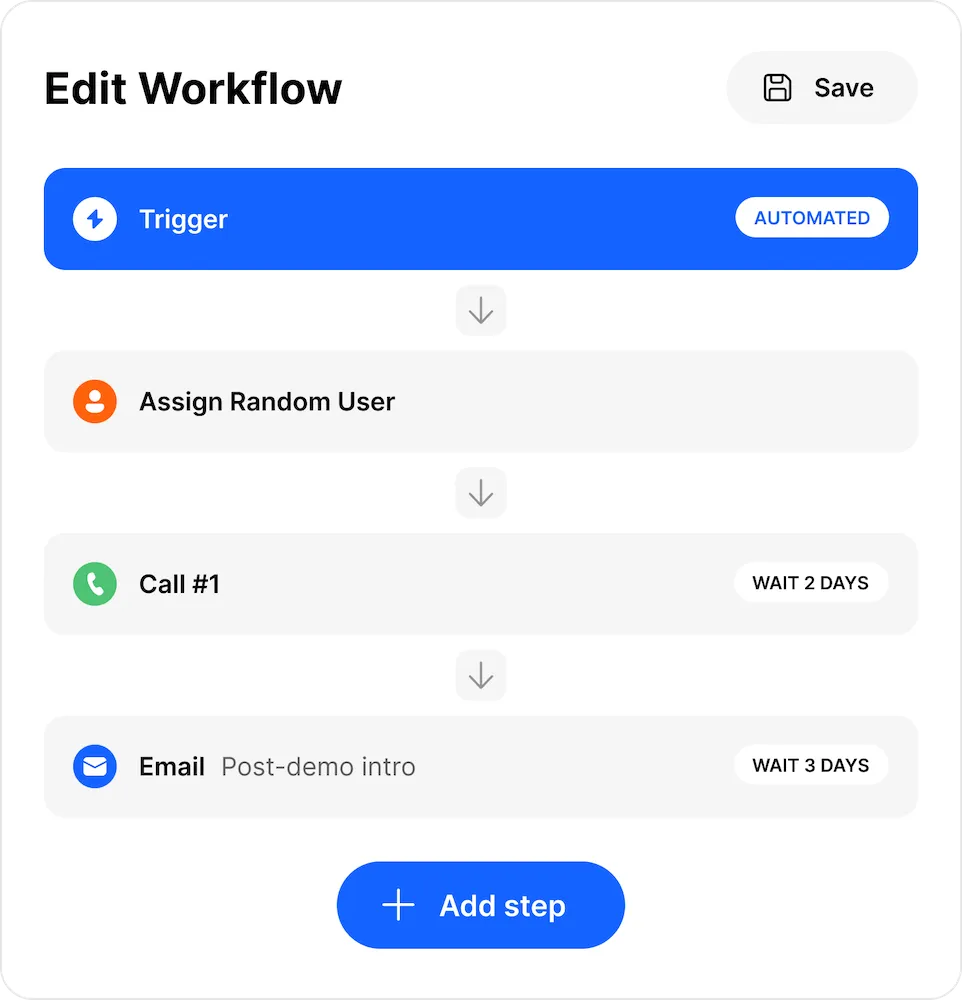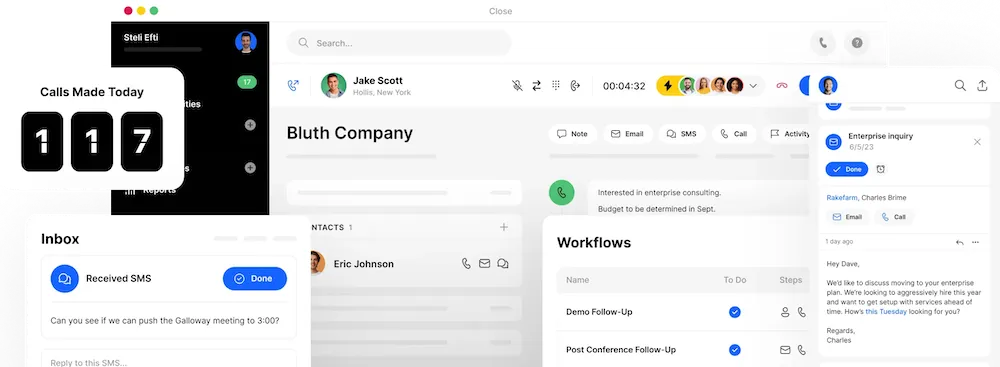
Quick, what’s the first thing that comes to mind when you hear the words: “cold calling?”
Do your palms get a little sweaty? (✋ Been there!) Do you think about that time someone yelled at you on the phone? (Been there, too.) Or, do you get excited about the new deal you might close?
Let’s be real—cold calling isn’t everyone’s favorite sales activity. I get it.
While it’s not all cupcakes and rainbows (or whatever makes you feel happy!), cold calling is still a highly effective way to connect with prospects—and, yes, close more deals.
If you’re considering dipping your toes into cold calling or want to improve your approach, I’ve got you covered. Let’s talk about how you can get started with cold calling (without the cold sweats.)
What is Cold Calling? (and Why Should You Care?)
Generally, cold calls go one of two ways:
- Successful cold calls pique the prospect’s interest and lead to follow-up meetings.
- Unsuccessful cold calls irritate prospects and end with curse words and abrupt hang-ups. (Kidding. Most cold calls are civil, though you should be prepared for anything.)
Modern cold calling isn’t just about making sales, it’s about starting conversations. Think less Dwight Schrute from The Office and more Will Smith in Pursuit of Happyness.
Of course, not everyone loves cold calling. Actually, Zippia found that 48 percent of sales reps are afraid of cold calling, and 63 percent identify cold calling as the worst part of their job.
Ouch. But honestly, I get it.
If you consider cold calling the bane of your existence, it’s fun reading articles saying that cold calling is dead. But the truth is—it’s alive and well.
In fact, research shows:
- 28 percent of cold call attempts are answered
- 82 percent of business buyers accept meetings with cold callers
- 57 percent of B2B C-level executives prefer to be contacted by phone
Clearly, cold calling should be a crucial part of the sales process for many sales reps. The good news is there’s a lot to love about cold calling.
Cold Calling Has Clear Benefits
If you’re still feeling overwhelmed by the idea of cold calling, don’t worry—that’s totally normal. Cold calling feels more invasive sometimes, and it can be very difficult to get it right. Plus, it’s harder to scale—after all, you can’t call 1,000 people at the same time, but you can easily contact them all by email in just a couple of clicks.
I also hated cold calling when I first got started in sales. Over time, I realized it has some knockout benefits, especially for small business owners and startup founders:
- Cold calling is the fastest way to find product-market fit for your business. There’s no other sales strategy that gives such an immediate response. You’ll know exactly how people feel about what you’re selling, right away.
- Second, speaking directly with potential customers helps you quickly determine whether they’re a good fit for your business. Qualifying can be time-consuming AF when you’re researching online or going back and forth via email. Cold calling lets you talk directly to these people and qualify them in real time.
- Cold calling is personalized. Talking to people on the phone is way more personal than an email or a text. Personal forms of communication build trust, and that’s one of the main ingredients for a healthy sales recipe.
- You can build deeper relationships in a shorter time with cold calling than with any other outreach message. In fact, the average conversion rate for cold calling is around 6.3 percent, while the average conversion rate for cold email is somewhere between 1 and 5 percent.
Ready to give cold calling a try? I promise you won’t be disappointed. But first, let’s talk about the elephant in the room – is it even legal?
Is Cold Calling Legal?
Yes, cold calling is legal—as long as you follow local regulations.
This includes the Telemarketing Sales Rule, the National Do Not Call Registry, the TCPA in the US, as well as GDPR regulations in Europe. If you’re going to do cold calling, take time to look at these regulations and make sure you’re following them.
There are a lot of scammers who use cold calling to get on the phone with people they want to scam. As a result, people are more and more wary of talking to someone they don’t know on the phone.
Here are three steps to help make sure you stay legal (and avoid looking like a scammer):
- Do not buy large calling lists. Just don’t. It's not effective and can land you in legal hot water.
- Introduce yourself as soon as the prospect answers, and be clear about why you’re calling.
- Be mindful of legal calling hours – 8 a.m. to 9 p.m. (local time).
- Never, ever ask for money on a phone call.
How to Start Cold Calling Successfully in Just 5 Steps
Whether you’re a small business owner, a founder building their first sales process, or a sales rep doing cold calls for the first time, you might feel a lot of anxiety before making a cold call.
I’ve been there. The best way to kill that fear? Replace it with a clear, proven cold calling strategy that you can wash-rinse-repeat, day after day.
If you’re starting from scratch, we’ve got you covered:
1. Build Your First Cold Call List
Building a cold call list should be your first task—so block some time to do your homework. Create a targeted list of companies you want to contact, then do some extra digging to pinpoint decision-makers and get their contact information.
It probably goes without saying, but I'm going to say it anyway: only add companies to your target call list who actually need your products and/or services.
I definitely recommend quality over quantity in this situation. A giant call list won't help you. A call list filled with red-hot leads will—even if it only has a dozen names on it.
How to build a list for sales calls:
- Find companies that fit your ideal customer profile: Once you know who you want to sell to, use prospecting tools like LinkedIn Sales Navigator or Crunchbase to find companies that fit those criteria.
- Find decision-makers and end-users within those companies: Take time to figure out who would actually use your product, plus who in the company can make purchase decisions. (For example, if you sell CRM software, you’ll want to identify the sales reps who’ll use the product, but also the sales manager or director with the authority to make that purchase.)
- Get their phone numbers: To collect phone numbers for cold calling, you can check personal profiles on LinkedIn or their personal website, ask your network, send an email, or use a tool like Clearbit or Leadfeeder.
2. Invest in Meaningful Prospect Research
Want to boost your success rate? Get to know your prospects a bit before beginning outreach.
In fact, 76 percent of top-performing sales professionals say they always do research before reaching out to prospects.
I don't care if you're the best cold caller in the history of the world. If you don't know your prospects (and the ideal customer you’re looking for) like the back of your hand, you won't succeed. So, do yourself a favor and study your prospects before you get them on the phone.
How to do research before dialing:
- Browse social media: Whether checking the profiles of the individuals you’re selling to or the companies you’re targeting, you can gain a lot of valuable insights from social media (especially places like LinkedIn). You might even connect with these people or engage with their posts—then, they might recognize your name, which can turn your cold call into a warm call. 🚀
- Do early qualifying: Qualification starts with research. Know what makes a good prospect (or a successful customer), and match your lead list to those criteria. This info can include the company size, location, company changes, or even a LinkedIn post asking for recommendations!
- Answer important questions: Who are these people? What goals do they want to achieve? What pain points do they struggle with? How can your company’s products or services improve their daily process? Answering these questions before the call will help you respond faster once you’re on the phone.
3. Create a Cold Call Script or Talk Tracks to Keep the Convo on Track
When the Kansas City Chiefs step on the football field, they have a plan. They've spent the entire week studying their opponent so when Sunday rolls around, they know which offensive plays and defensive alignments will help them win.
You need a plan, too. Your plan is called a sales script. Cold call scripts and talk tracks help guide you through the conversation, without making you sound like a robot. Take everything you've learned about your prospects—their likes, dislikes, daily challenges, etc.—and combine it with your company's value proposition to stimulate your prospect's interest.
How to create sales scripts for more effective cold calling:
- Develop a clear, succinct pitch: Your sales pitch should clearly explain why you’re contacting this person, and why they should care.
- Ask open-ended questions: These questions help you discover whether this person is the right fit while helping them to gain more context about your product. Ask things like “What is your current process for X?” or “What is your biggest challenge with X?” (With X being something related to your product!)
- Lead the prospect to the next step: One of the most effective cold calling techniques I use is to purposely NOT try to sell anything. Remember, your goal is to get them to the next step in your sales process—so, use this conversation to sell them on that next step, not close the deal.
- Create a separate script for voicemails: Don’t get stuck when you hear the beep. Prepare a short voicemail script that includes your name, why you’re calling, and a specific next step. Even if people don’t respond, they’ll recognize your name when you call again.
4. Prepare in Advance to Overcome Objections
Every SDR, sales team, or business owner has to deal with objections. The way you handle them will largely determine the number of follow-up calls or in-person meetings you book. Which means—you need to get this right!
Some common objections you'll hear are:
- "It's too expensive."
- "I don't need this product/service right now."
- "I already use a similar product/service."
- "Now is not a good time."
- “I need to run this by my boss."
When you have clear answers prepared, you’ll sound more confident on the phone and show you’re concerned about your prospect’s needs.
How to handle objections on the first call:
- List out the top objections your sales team hears, and create templated answers: You’ll know exactly what to say when your prospect throws an objection at you. Remember, the goal isn’t to read this line by line (and sound like a robot!) but just have a general response ready.
- Listen carefully with the goal to understand: Don’t assume you know what an objection is about. (Meaning, don’t be a jerk and cut them off!) Take the time to ask questions and understand where they’re coming from. Your prospects will appreciate you’re taking their concerns seriously.
5. Prep Your Follow-Up Workflow
There are two types of following up with cold calling:
- First, you’ll follow up with the prospects you spoke to and set up clear next steps to move the conversation forward.
- Second, you’ll need to follow up with the people who didn’t pick up the phone the first time you called.
Let’s face it: you don’t always get in contact with someone the first time you call. In fact, it can take up to eight calls to reach a prospect in your cold calling process. Which means you’ll need to be persistent.
Setting up a follow-up workflow is key to moving from a list of cold leads to a CRM full of happy customers.
How to build your follow-up workflows:
- Make sure you know when you’ll talk to this person again: This should happen before you hang up. Make sure during the call you set up clear next steps. Whether you set a follow-up meeting, another call, or a product demo, make sure you know exactly when you’ll speak to them again.
- Set up cold outreach workflows in Close: With our powerful automation features, you can set up new cold outreach cadences in Close and put your follow-up strategy on auto-pilot. Simply set a trigger, build out your steps, and let it run!
 |
Final Thoughts: Cold Calling Tips to Nail Your Next Call
Just like a pro gymnast who sticks the landing every time, you need to practice your skills over and over to maximize the time you spend in the air (or, in this case, on the phone.)
Here are some of our top cold calling tips to make sure your next cold call is successful:
- Keep your main goal in mind: When you cold call a lead, you’re not trying to sell—you’re trying to connect. Use this time to discover fit and convince them to move on to the next step. Focus more on your prospect (and less on your product) to improve your success rate.
- Hit the right tone of voice: Tonality matters a ton—since prospects can’t see you, they’ll interpret all non-verbal communication through your tone of voice. Practice your scripts and talk tracks so you sound confident, speak clearly, and use a steady pace (not too fast, not too slow, just right).
- Choose opening lines that capture attention: The best opening lines cover four important points—who you are, what you’re offering, why you’re calling, and what the goal of the call is. Try different opening lines to see which ones resonate best with your target audience.
- End the call with clear next steps: Whether that’s a meeting, a product demo, or another call. If you can’t get them to commit, simply tell them when you plan to reach back out. You could say something like, "I'll call you again next Tuesday. That way, we can talk about [your offering] in more detail. Does that work for you?"
- Listen back to your cold calls to improve: The best way to get better at cold calling ist to listen to yourself. I know you’d rather listen to nails on a chalkboard than the sound of your own voice, but trust me: this is the single best way to improve your cold calling skills.
You’ve got the best cold calling techniques and tips—all you need is the right software to complement your strategy. Try Close CRM today to see how this powerhouse sales tool can help you close more deals, faster.
 |











